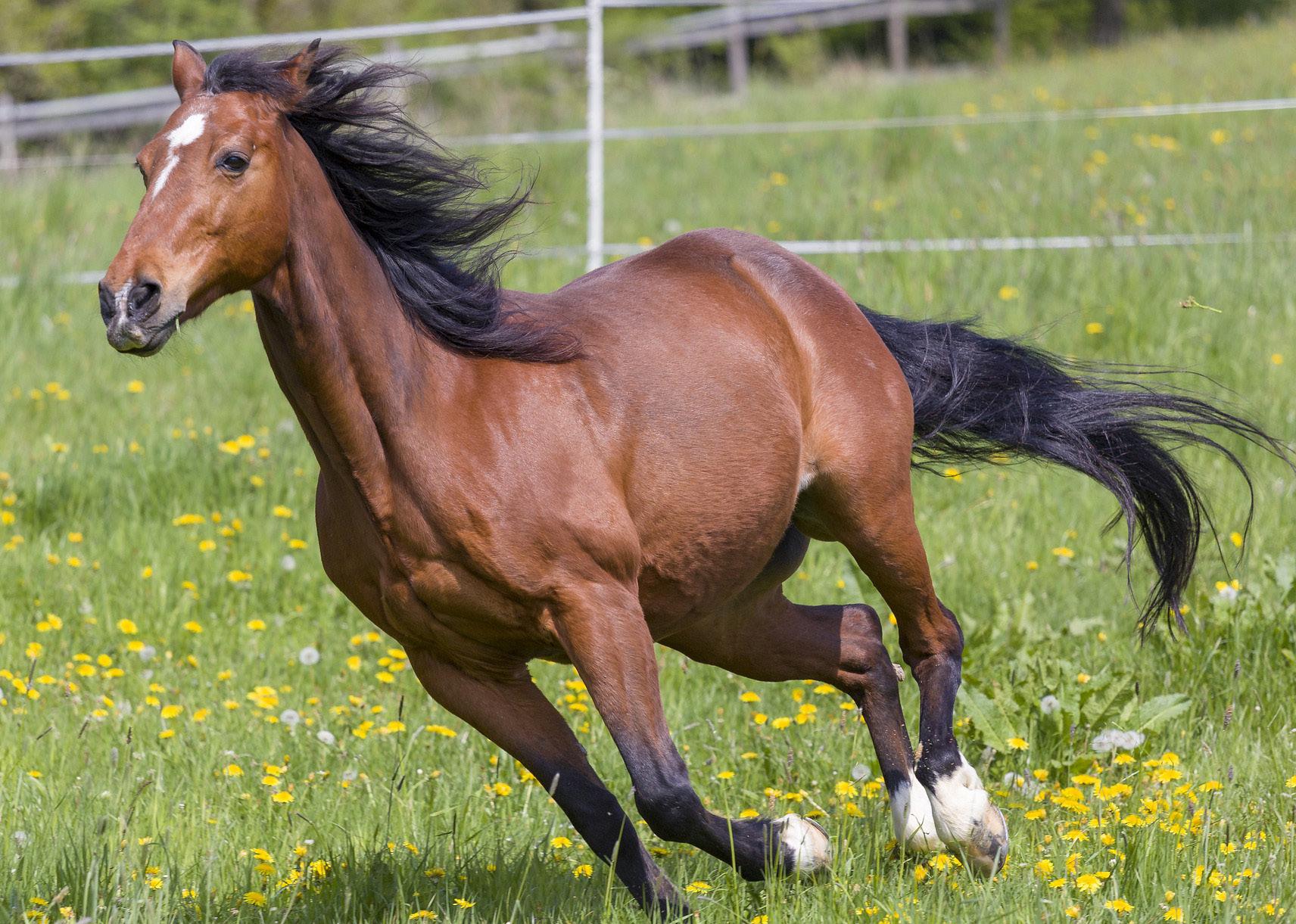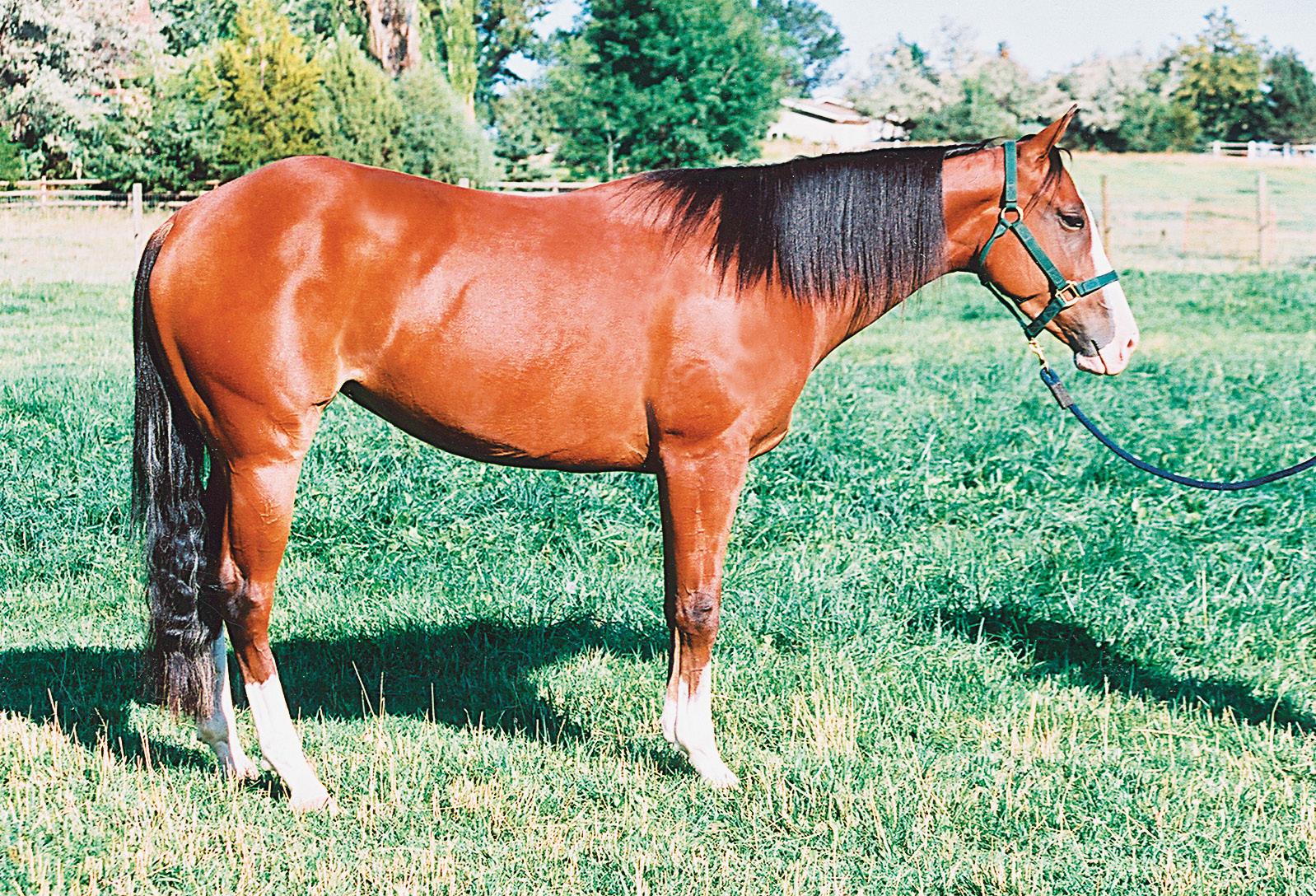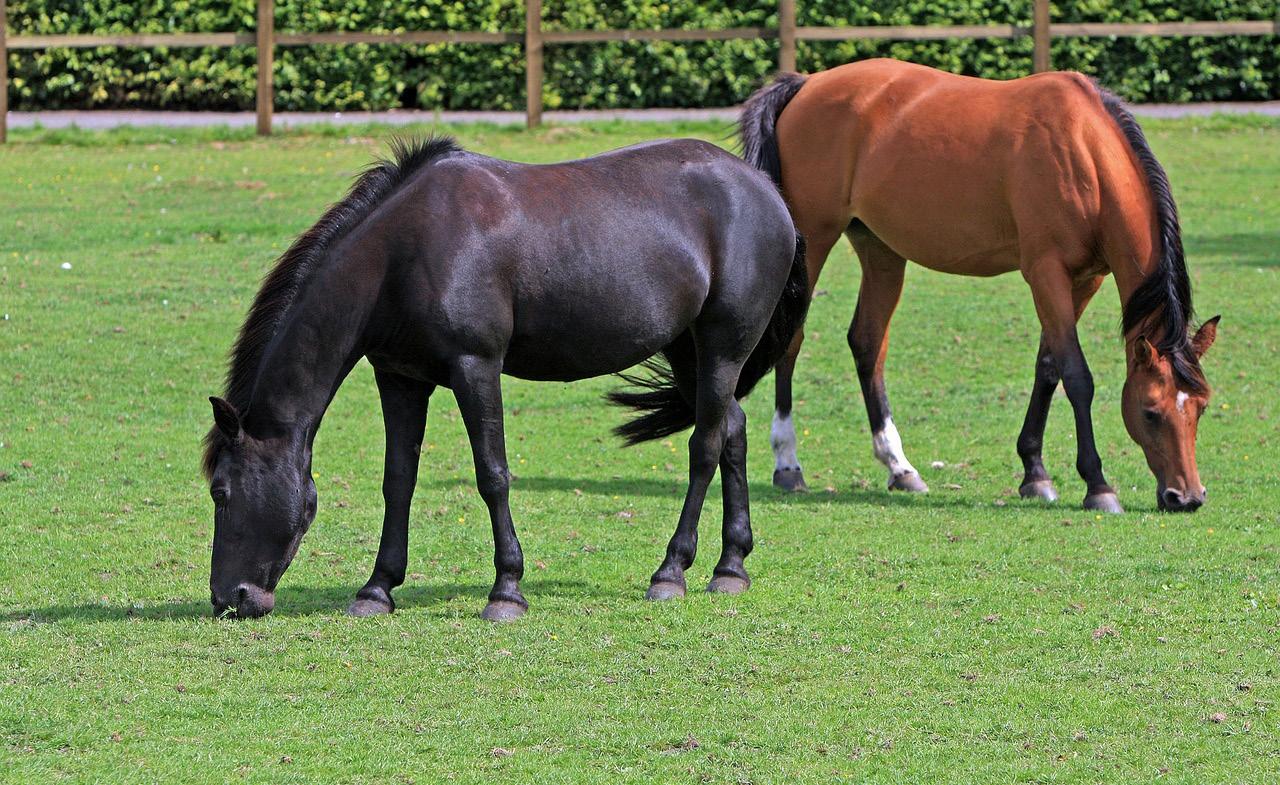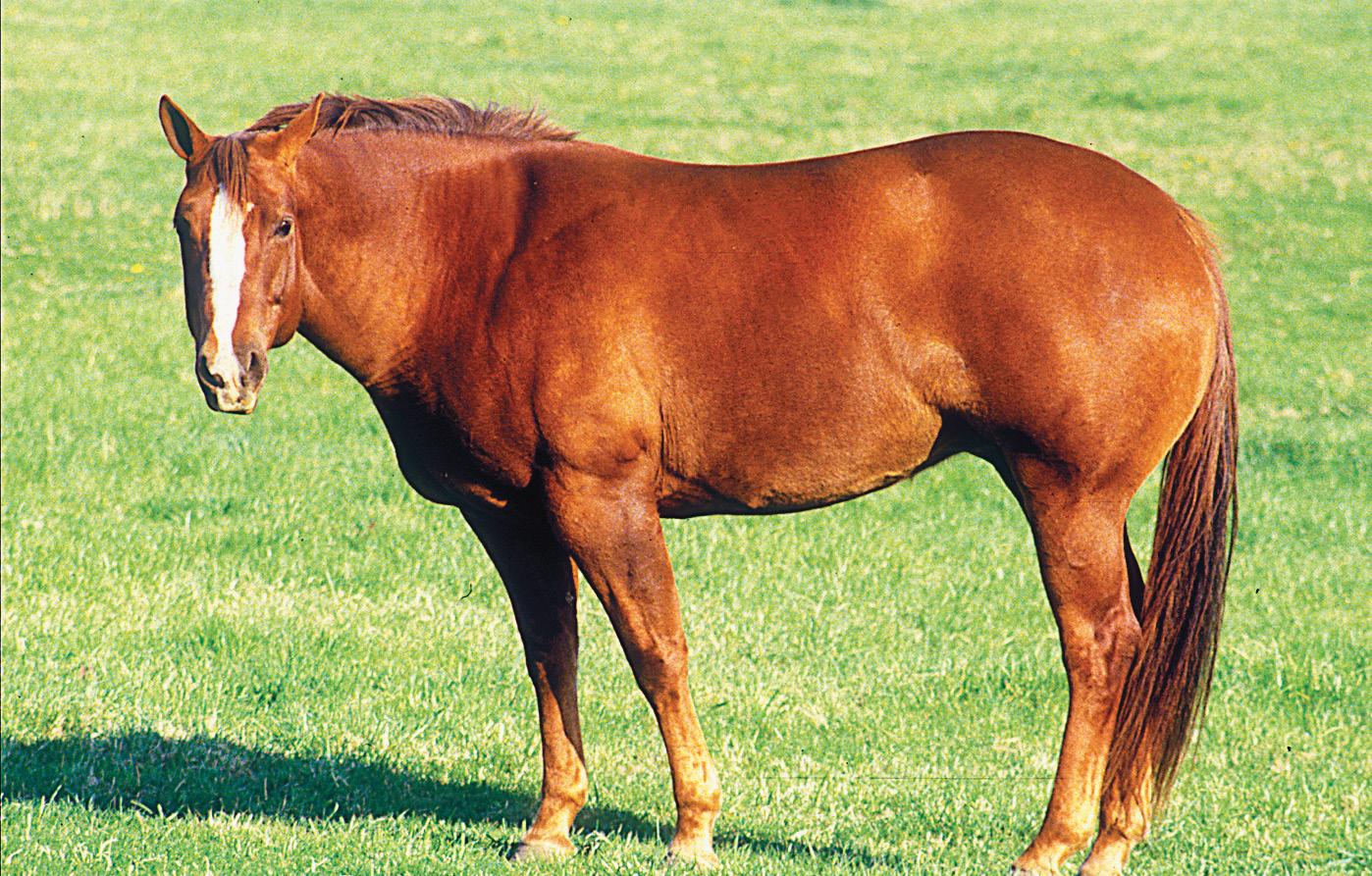
7 minute read
Your Healthy Horse
From Fat to Fit
Ready to get your horse fit for the busy travel and riding season? Here’s a 10-step weight-loss plan to get you started.
By Eleanor M. Kellon, VMD
A fit horse is a happy horse, and one with the energy and motivation to frolic. Read on for ways to get your horse ready for the busy travel and riding season.
>> Horses become overweight for the same reason we do—they eat more calories than they burn. It isn’t any healthier for them than it is for us. Your overweight horse is stressing his joints, heart, and lungs, and has a difficult time regulating his body temperature during exercise, which can lead to dangerous overheating and heat stroke, especially as we head into spring and summer.
Following is a 10-step weight-loss plan to help you get your horse moving from fat to fit. Plus, I’ll explain what to look for in a feed supplement, and give you a hay-equivalent chart and a lean menu (page 20).
Not too fat, not too thin, this young mare is just right. Ask your veterinarian to estimate what your horse’s normal healthy weight should be.

10-Step Plan Step 1. Get a healthy weight. Ask your veterinarian to estimate what your horse’s normal healthy weight should be. Involve your vet in your horse’s weight-loss program, and follow his or her advice and recommendations. Step 2. Monitor his weight. Use a weight tape to keep track of your horse’s weight loss. Weight losses of between 40 and 75 pounds per month can be expected with the program here. Don’t be in any rush to get the weight off. Your horse didn’t put it on overnight, and he won’t lose it overnight either. It’s better to go for steady weight loss with your horse getting enough to eat to feel satisfied. Step 3. Provide regular exercise. Exercise is an important part of your horse’s weight-loss program. Turnout is better than stall confinement, but it’s not the same thing as formal exercise, where you keep him moving for at least 20 minutes. Regular exercise does more than just burn some calories; it changes the way your horse’s body handles those calories. For up to 24 hours after exercise, calories are diverted to his muscles to replace energy stores there, repair any minor damage, and build muscle bulk. On days you can’t ride, longe your horse, or work him in the round pen. If you can’t be there at all, ask a friend to work your horse for you. Step 4. Consider a grazing muzzle. If you turn your horse out on pasture, consider investing in a grazing muzzle. I recommend The Best Friend Muzzle, which is sturdy, stays in place well, has breakaway features in case of accidental snagging, and restricts grazing, but not drinking. It also has a plug for the end to prevent grazing completely. Never underestimate the amount of grass a horse can pack away in just an hour. In fact, in some cases of moderately overweight horses, preventing grass intake may be all you need to do to get the desired weight loss. Step 5. Evaluate your horse’s current diet. Figure out how much grain and hay you’re feeding your horse. If you feed more than hay, use the hay-equivalent Round-the-clock foraging is the most natural way for horses to eat, but “easy-keepers,” left to satisfy their own appetites, may consume more calories than they need.

chart to figure how many calories you’re feeding in hay equivalents. For example, most horses weighing about 1,000 pounds will hold a normal weight eating 20 to 25 pounds of hay per day. If you’re feeding your mildly overweight horse 20 pounds of hay plus 5 pounds of a commercial grain mix, you’re giving him the equivalent of 32.5 to 35 pounds of hay because of the grain’s higher calorie level. Cut out concentrated calorie sources first, that is, grain and fat. Step 6. Feed him the right amount. Feed your horse about two percent of his ideal body weight every day. Step 7. Feed a variety of hay types. The more varieties of hay you feed your horse, the better chance his mineral intake will be fairly well-balanced. Step 8. Feed a balanced supplement. If you know your horse’s mineral intake is balanced, you can give him a balanced pelleted supplement instead of grain at mealtime. These are usually fed at a rate of about 1 pound per day. (For selection guidelines, see “The Right Supplement,” on the next page.) Step 9. Choose a lean menu. Choose from the lean menu if it makes you feel better to give your horse a more substantial amount in his feed tub. Check the hay equivalents, so you know how much to subtract from the amount of hay you’re feeding. Note that if you choose to give your horse a feed formulated to be low calorie, you won’t also need to feed him a protein/mineral supplement if the feed is highly supplemented. As a guide, use the label guaranteed copper content. If the feed contains more than 110 parts per million (ppm) copper, don’t feed any additional supplement. If the feed contains less than 110 ppm, feed half the recommended dose of the protein/mineral supplement. Step 10. Stick to the diet. Once you get your horse on a healthy weight-loss program, don’t disrupt it by feeding him high-sugar, high-starch “cookies,” donuts, High-quality alfalfa hay tends to provide slightly more energy and protein than an equal amount of grass hay, so you may need to feed less of it. PHOTO BY BETSY LYNCH Food Approximate Hay Equivalent Hay 1 lb. hay = 1 lb. hay Plain Grains 1 lb. plain grain = 2 lbs. hay Commercial Grain Mixes 1 lb. grain mix = 2.5 to 3 lbs. hay Fats and Oils 1 lb. fat/oil = 3.6 to 4 lbs. hay Hay Equivalents Lean Menu Meal Hay Calorie Reduction (compared to 25 lbs. of commercial grain mix) 1/2 lb. dry beet pulp, 2 oz. flax seed or 2 tbsp. wheat germ, plus supplement. Soak beet pulp before feeding. 1 lb. hay 84% reduction 2 lbs. alfalfa or grass hay pellets or cubes, plus supplement. 2.5 lbs. hay 60% reduction 1/2 lb. carrots, 1/2 lb. celery, 1/2 lb. summer squash, all cut in chunks, plus supplement. 1 lb. hay 84% reduction 1 lb. high-fiber, lowfat, or “lite” feed. 2 lbs. hay 68% reduction >>

candy, or any human food. Instead, substitute small amounts of fresh green vegetables, apple peel (no sweet fruits), sugar-free peppermints, a few mint-flavored antacids, and/or alfalfa pellets/cubes.

The Right Supplement Look for a feed supplement that’s high fiber, low carbohydrate, and low fat. Note that horse feeds aren’t required to list the main ingredient first and other ingredients in descending order like human food labels do. A feed may list alfalfa or “forage products” first and corn last, but still have just as much corn in it as hay, or even more.
You can find clues, though. First, check the fat content. A horse that needs to lose weight should never be eating something higher than 3% to 4% fat. Also, unless the feed specifically states it’s low calorie, avoid feeds with molasses in the ingredients list. Some have very small amounts, while others have quite a lot. It’s not necessarily easy to tell how much is in there, especially with a pelleted feed.

Good, leafy grass hay is a great “diet food” for most horses, but even grass hay needs to be weighed and fed at 1.5% to 2% of your horse’s “ideal” body weight to get him to start shedding extra pounds. PHOTO BY BETSY LYNCH This mare is undeniably heavier than is healthy for her. Obesity puts her at greater risk for laminitis, lameness, and colic. PHOTO BY BETSY LYNCH
Crude fiber doesn’t necessarily correlate directly with calories, because high-soluble fiber ingredients, such as beet pulp, are actually more calorie dense than hays. But it’s a fairly good indication of how much grain/grain products are in a feed. Look for a feed with at least 20% fiber. Some complete feeds fit the bill, too, and make good substitutes for straight grains.
In addition to the fat and fiber content, check the feeding directions. If the feed calls for giving the horse about 1.5% of his body weight/day when used as a complete feed (i.e., 15 lbs. per day for a 1,000-pound horse not in work), it has a calorie content similar to a high-quality hay. USR
Eleanor M. Kellon, VMD, the owner of Equine Nutritional Solutions in Robesonia, Pennsylvania, is one of a handful of experts in the field of applications of nutraceuticals for horses. She’s an authority in the field of equine nutrition, as well as conditions affecting performance horses. Dr. Kellon’s books include Equine Supplements and Nutraceuticals (Breakthrough Publications). It’s a Long Road Ahead. ARE YOU COVERED?
Offering 24/7 Nationwide Roadside Assistance for You and Your Horse. JOIN TODAY.
(800) 844-1409 www.USRIDER.ORG

Administered by Nation Motor Club Inc., DBA Nation Safe Drivers










